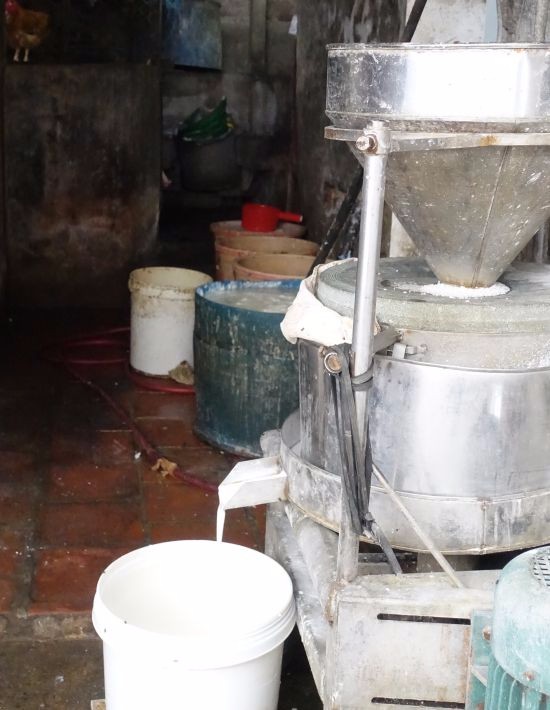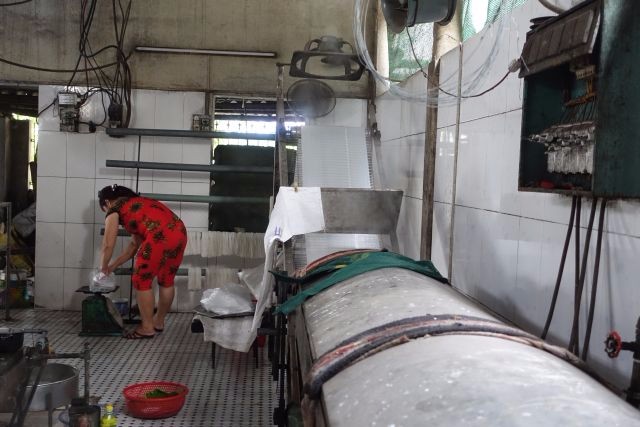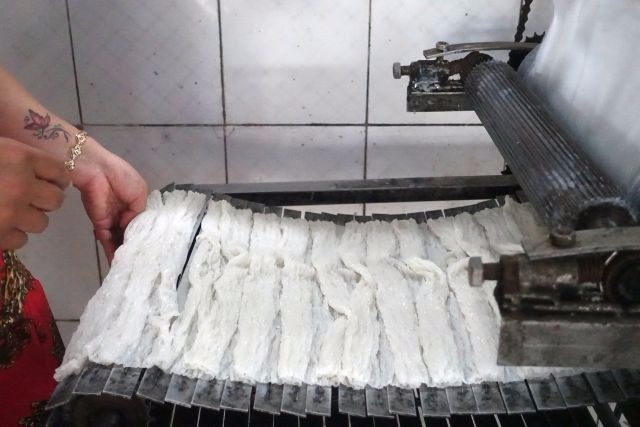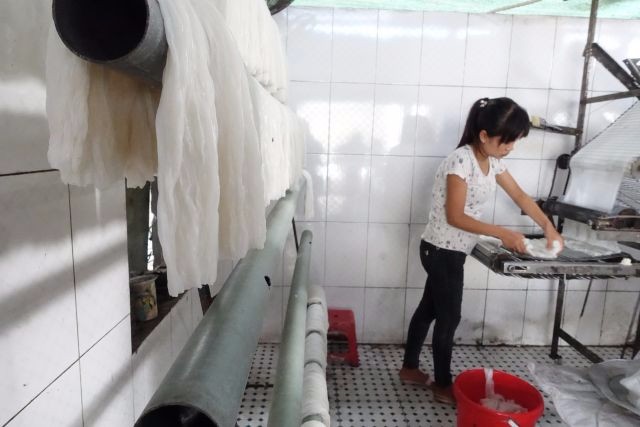Banh Cuon Phu Ly is a delightful Vietnamese dish that you absolutely can observe being made, and SIXT.VN is here to guide you through the experience! This savory steamed rice roll is a culinary gem, particularly renowned in the Phu Ly region. Discover the intricate steps involved in crafting this local delicacy, from preparing the rice batter to the artful steaming and filling process, offering a unique glimpse into Vietnamese cuisine and culture.
1. What Exactly is Banh Cuon Phu Ly?
Banh Cuon Phu Ly is a variation of the popular Vietnamese dish, Banh Cuon, known for its delicate, steamed rice paper rolls filled with a savory mixture. Originating from Phu Ly, a city in Ha Nam province, Vietnam, this version distinguishes itself through the use of high-quality local ingredients and a unique preparation style that has been passed down through generations. It’s a beloved breakfast and snack item, offering a light yet satisfying culinary experience.
1.1. The Essence of Banh Cuon
Banh Cuon, at its core, is a testament to the simplicity and elegance of Vietnamese cuisine. The dish features thin sheets of steamed rice batter, almost translucent, that are skillfully rolled and filled. The fillings typically consist of ground pork, minced wood ear mushrooms, and shallots, providing a delightful combination of textures and flavors. Often served with a side of nuoc cham (fish sauce dipping sauce), fresh herbs, and crispy fried shallots, Banh Cuon offers a harmonious blend of savory, sweet, and aromatic elements.
1.2. Phu Ly’s Contribution to Banh Cuon
Phu Ly elevates the Banh Cuon experience by emphasizing the quality and freshness of local ingredients. The rice used for the batter is carefully selected, often sourced from specific fields known for producing grains with the perfect starch content. The pork and mushrooms are also locally sourced, ensuring optimal flavor and texture. The skill of the local chefs in Phu Ly is evident in the delicate balance of flavors and the precise steaming technique, resulting in a Banh Cuon that is both refined and deeply satisfying.
1.3. Popularity and Cultural Significance
Banh Cuon Phu Ly is not just a dish; it’s a cultural icon. It represents the culinary heritage of the region and the dedication of its people to preserving traditional techniques. The dish is a popular choice for breakfast, enjoyed by locals and visitors alike, and is often served at family gatherings and special occasions. Its popularity has spread beyond Phu Ly, attracting food enthusiasts from all over Vietnam and the world, eager to experience this unique culinary treasure.
2. What Are the Key Ingredients Required for Banh Cuon Phu Ly?
Creating authentic Banh Cuon Phu Ly involves using specific, high-quality ingredients that contribute to its distinctive flavor and texture. The key ingredients include rice flour, tapioca starch, ground pork, wood ear mushrooms, shallots, and, of course, the essential dipping sauce, nuoc cham.
2.1. Rice Flour: The Foundation
The base of Banh Cuon is the rice flour, which must be of excellent quality to achieve the desired thinness and tenderness of the steamed sheets. The type of rice flour used significantly impacts the final product. According to traditional recipes, aged rice flour is preferred because it absorbs water more evenly, resulting in a smoother batter.
2.2. Tapioca Starch: The Texture Enhancer
Tapioca starch is added to the rice flour mixture to enhance the elasticity and translucency of the Banh Cuon sheets. The right proportion of tapioca starch ensures that the rolls are neither too sticky nor too brittle, giving them the perfect texture that melts in your mouth.
2.3. Ground Pork: The Savory Filling
The savory filling of Banh Cuon Phu Ly primarily consists of ground pork. The pork should be lean yet flavorful, providing a rich and satisfying taste. Seasoning the ground pork with salt, pepper, and a touch of sugar enhances its natural flavors, making it a delectable component of the dish.
2.4. Wood Ear Mushrooms: The Earthy Note
Wood ear mushrooms, also known as black fungus, are a vital ingredient in the filling. These mushrooms add a unique earthy flavor and a delightful crunchy texture to the Banh Cuon. They are typically soaked in warm water to rehydrate before being finely chopped and mixed with the ground pork.
2.5. Shallots: The Aromatic Touch
Shallots are used both in the filling and as a topping for Banh Cuon Phu Ly. Finely minced shallots are sautéed until golden brown and crispy, adding a fragrant aroma and a delightful crunch to the dish. Their slightly sweet and savory flavor complements the other ingredients perfectly.
2.6. Nuoc Cham: The Soul of the Dish
No Banh Cuon is complete without nuoc cham, the iconic Vietnamese dipping sauce. Made from fish sauce, water, sugar, lime juice, and chili, nuoc cham provides the perfect balance of sweet, sour, salty, and spicy flavors. The quality of the fish sauce is crucial, as it forms the foundation of this essential condiment.
2.7. Fresh Herbs: The Refreshing Element
Fresh herbs such as Vietnamese coriander, mint, and basil are typically served alongside Banh Cuon Phu Ly. These herbs add a refreshing element to the dish, cutting through the richness of the filling and providing a burst of aromatic flavors.
2.8. Optional Additions
While the above ingredients are essential, some variations of Banh Cuon Phu Ly may include additional ingredients such as shrimp, bean sprouts, or ground chicken. These additions offer different flavors and textures, allowing for a customized culinary experience.
 Pho-noodle-grinding-rice
Pho-noodle-grinding-rice
3. What Equipment is Needed to Make Banh Cuon Phu Ly?
To successfully create Banh Cuon Phu Ly, you’ll need specific equipment that facilitates the steaming and rolling process. Essential tools include a flat-bottomed steamer, a thin cloth or muslin, a ladle, a bamboo stick, and a non-stick pan.
3.1. Flat-Bottomed Steamer
The heart of Banh Cuon preparation is a flat-bottomed steamer. This specialized steamer is designed to evenly distribute heat, ensuring that the rice batter is cooked uniformly. The flat bottom allows the steamer to sit stably on the stovetop, providing a consistent cooking environment.
3.2. Thin Cloth or Muslin
A thin cloth or muslin is stretched tightly over the steamer to create a smooth surface for steaming the rice batter. The cloth must be heat-resistant and allow steam to pass through while preventing the batter from sticking. This ensures that the Banh Cuon sheets are thin, delicate, and easy to peel off.
3.3. Ladle
A ladle is used to pour the rice batter onto the steaming cloth. The size of the ladle should be appropriate for creating the desired size of the Banh Cuon sheets. Precision in pouring the batter is essential for achieving uniform thickness.
3.4. Bamboo Stick
A thin bamboo stick is used to gently peel the steamed rice sheet from the cloth and roll it up. The bamboo stick is flexible and non-abrasive, preventing the delicate Banh Cuon from tearing. The skill in using the bamboo stick comes with practice, allowing for quick and efficient rolling.
3.5. Non-Stick Pan
A non-stick pan is used to sauté the shallots until they are golden brown and crispy. The non-stick surface prevents the shallots from sticking and burning, ensuring that they are evenly cooked and maintain their aromatic flavor.
3.6. Mixing Bowls
Mixing bowls are necessary for preparing the rice batter and the filling. Different sizes of bowls are useful for keeping the ingredients separate and organized. Using high-quality mixing bowls makes the preparation process smoother and more efficient.
3.7. Chopping Board and Knife
A chopping board and a sharp knife are essential for preparing the ingredients for the filling, such as chopping the wood ear mushrooms and shallots. A good quality knife ensures precision and safety in the kitchen.
3.8. Measuring Cups and Spoons
Accurate measurements are crucial for achieving the right consistency of the rice batter and the balance of flavors in the nuoc cham. Measuring cups and spoons help ensure that the ingredients are added in the correct proportions.
3.9. Optional Equipment
Some cooks may prefer to use additional equipment such as a food processor for grinding the pork or a steamer basket for steaming the Banh Cuon in batches. These tools can streamline the preparation process and enhance the overall cooking experience.
4. What is the Step-by-Step Process of Making Banh Cuon Phu Ly?
The process of making Banh Cuon Phu Ly involves several key steps, from preparing the rice batter to steaming, filling, and serving. Each step requires attention to detail to ensure the final product is perfect.
4.1. Preparing the Rice Batter
The first step is preparing the rice batter. Combine rice flour and tapioca starch in a mixing bowl. Gradually add water, mixing continuously until you achieve a smooth, milky consistency. Let the batter rest for at least 30 minutes to allow the rice flour to fully absorb the water. This resting period is crucial for achieving the right texture of the Banh Cuon sheets.
4.2. Preparing the Filling
While the batter is resting, prepare the filling. Soak wood ear mushrooms in warm water until they rehydrate, then finely chop them. In a separate bowl, combine ground pork, chopped mushrooms, minced shallots, salt, pepper, and a touch of sugar. Mix well and set aside. This savory filling is what gives Banh Cuon its distinctive flavor.
4.3. Setting Up the Steamer
Set up your flat-bottomed steamer by filling it with water and bringing it to a boil. Stretch the thin cloth or muslin tightly over the steamer, ensuring it is smooth and secure. The cloth should be slightly damp to prevent the batter from sticking. This creates the perfect surface for steaming the Banh Cuon sheets.
4.4. Steaming the Banh Cuon Sheets
Once the steamer is ready, ladle a thin layer of rice batter onto the cloth, spreading it evenly to form a thin sheet. Cover the steamer and let it steam for about 1-2 minutes, or until the sheet is cooked through and slightly translucent. The steaming time may vary depending on the thickness of the batter and the heat of the steamer.
4.5. Adding the Filling
Carefully remove the steamed rice sheet from the cloth using a bamboo stick. Place it on a clean surface and spoon a small amount of the pork and mushroom filling onto one end of the sheet. Gently roll the sheet up, encasing the filling. This step requires a delicate touch to prevent the Banh Cuon from tearing.
4.6. Sautéing the Shallots
In a non-stick pan, sauté finely minced shallots until they are golden brown and crispy. This adds a fragrant and crunchy topping to the Banh Cuon. The shallots should be stirred frequently to prevent burning.
4.7. Preparing the Nuoc Cham
Prepare the nuoc cham by combining fish sauce, water, sugar, lime juice, and chili in a bowl. Adjust the proportions to achieve the perfect balance of sweet, sour, salty, and spicy flavors. The nuoc cham is the soul of the dish, providing the essential dipping sauce that complements the Banh Cuon.
4.8. Serving the Banh Cuon Phu Ly
Arrange the Banh Cuon rolls on a plate. Garnish with crispy fried shallots and fresh herbs such as Vietnamese coriander, mint, and basil. Serve immediately with a side of nuoc cham for dipping. The Banh Cuon is best enjoyed fresh, while the sheets are still warm and tender.
4.9. Optional Additions and Variations
For added flavor and texture, consider adding steamed bean sprouts or blanched shrimp to the filling. Some variations of Banh Cuon Phu Ly may also include a drizzle of scallion oil or a sprinkle of ground roasted peanuts. These additions can enhance the overall culinary experience.
 Pho-noodle-dispensing-batter
Pho-noodle-dispensing-batter
5. Where Can You Observe Banh Cuon Phu Ly Being Made?
To witness the creation of Banh Cuon Phu Ly firsthand, head to Phu Ly city in Ha Nam province, Vietnam. Numerous local eateries and street vendors specialize in this dish, often preparing it fresh in front of customers.
5.1. Local Eateries in Phu Ly
Phu Ly is renowned for its Banh Cuon, and many local eateries take pride in showcasing the traditional preparation methods. These establishments often feature open kitchens where you can observe the entire process, from the grinding of the rice to the steaming of the sheets and the artful rolling of the Banh Cuon.
5.2. Street Vendors
Street vendors in Phu Ly are another excellent option for observing Banh Cuon preparation. Many vendors set up their mobile kitchens early in the morning, offering freshly made Banh Cuon to locals and tourists alike. Watching them skillfully prepare the dish on the spot is a unique cultural experience.
5.3. Culinary Tours
Consider joining a culinary tour in Phu Ly or Ha Nam province. These tours often include visits to local Banh Cuon makers, providing you with an insider’s view of the process and the opportunity to taste the dish at its freshest. SIXT.VN can assist in arranging such tours, ensuring a memorable culinary adventure.
5.4. Homestays and Cooking Classes
Some homestays in the Phu Ly region offer cooking classes that focus on local specialties, including Banh Cuon. These classes provide hands-on experience in making the dish, allowing you to learn the traditional techniques and secrets from local chefs.
5.5. Markets
Visiting local markets in Phu Ly can also offer glimpses into the Banh Cuon making process. Some vendors prepare the rice batter and steam the sheets at the market, providing a fascinating look at the ingredients and techniques involved.
5.6. Festivals and Events
Keep an eye out for local festivals and events in Phu Ly, where Banh Cuon is often featured as a highlight. These events provide an opportunity to witness large-scale Banh Cuon preparation and enjoy the dish in a festive atmosphere.
5.7. Recommendations from Locals
Ask locals for their recommendations on the best places to observe Banh Cuon being made. They can often point you to hidden gems and family-run businesses that have been perfecting the art of Banh Cuon for generations.
5.8. Cultural Centers
Check if any cultural centers or museums in Phu Ly or Ha Nam province offer demonstrations or exhibits on local cuisine, including Banh Cuon. These centers can provide valuable insights into the history and cultural significance of the dish.
 Pho-noodle-steaming
Pho-noodle-steaming
6. What Variations of Banh Cuon Exist Across Vietnam?
While Banh Cuon Phu Ly is a regional specialty, many variations of the dish exist across Vietnam, each with its own unique ingredients, fillings, and preparation styles.
6.1. Northern Style Banh Cuon
In northern Vietnam, Banh Cuon is often served with cha lua (Vietnamese pork sausage) and fried shallots. The dipping sauce tends to be lighter and less sweet than in other regions. The emphasis is on the simplicity and freshness of the ingredients.
6.2. Central Style Banh Cuon
In central Vietnam, Banh Cuon is sometimes filled with a mixture of ground shrimp and pork, adding a seafood element to the dish. The dipping sauce may include fermented shrimp paste (mam tom) for a more pungent flavor.
6.3. Southern Style Banh Cuon
In southern Vietnam, Banh Cuon is often served with a variety of accompaniments, including bean sprouts, cucumbers, and herbs. The dipping sauce tends to be sweeter and more complex, with a generous amount of sugar and lime juice.
6.4. Banh Cuon Thanh Tri
Banh Cuon Thanh Tri, from Hanoi, is known for its thin, delicate sheets that are often served without any filling. Instead, they are enjoyed with a side of cha lua and a flavorful dipping sauce. The focus is on the texture and aroma of the rice sheets.
6.5. Banh Cuon Nong
Banh Cuon Nong, or “hot Banh Cuon,” is a variation where the steamed rice sheets are served immediately, while still warm. This ensures a soft and tender texture that is highly prized by connoisseurs.
6.6. Banh Cuon Trung Ga
Banh Cuon Trung Ga includes an egg in the batter, adding richness and flavor to the rice sheets. The egg also gives the Banh Cuon a slightly yellow color and a more substantial texture.
6.7. Banh Cuon Cha Com
Banh Cuon Cha Com is served with cha com, a type of green rice cake that is popular in Hanoi. The combination of the soft Banh Cuon and the chewy cha com provides a unique textural contrast.
6.8. Creative Variations
Some modern variations of Banh Cuon include unconventional fillings such as vegetarian options, seafood medleys, or even Western-inspired ingredients. These creative twists reflect the evolving culinary landscape of Vietnam.
7. What Are the Health Benefits of Eating Banh Cuon Phu Ly?
Banh Cuon Phu Ly offers several health benefits due to its nutritious ingredients and cooking method.
7.1. Low in Fat
Banh Cuon is typically steamed, which means it is low in fat compared to fried dishes. This makes it a healthier option for those watching their fat intake.
7.2. Gluten-Free
As it is made from rice flour, Banh Cuon is naturally gluten-free, making it a suitable choice for individuals with gluten sensitivities or celiac disease.
7.3. Source of Carbohydrates
The rice flour provides a good source of carbohydrates, which are essential for energy production. Carbohydrates are the body’s primary fuel source, providing sustained energy for daily activities.
7.4. Protein-Rich
The filling, which usually includes ground pork and mushrooms, adds protein to the dish. Protein is vital for building and repairing tissues, supporting immune function, and maintaining overall health.
7.5. Rich in Vitamins and Minerals
The vegetables and herbs served with Banh Cuon, such as bean sprouts, cucumbers, and Vietnamese coriander, are rich in vitamins and minerals. These nutrients support various bodily functions, from boosting immunity to promoting healthy skin.
7.6. Digestive Benefits
The steamed preparation and the inclusion of fresh herbs can aid digestion. Herbs like mint and basil have digestive properties that can help soothe the stomach and promote healthy gut function.
7.7. Hydrating
Banh Cuon is often served with a generous amount of dipping sauce, which can help keep you hydrated. Staying hydrated is essential for maintaining energy levels, regulating body temperature, and supporting overall health.
7.8. Balanced Nutrients
When consumed as part of a balanced diet, Banh Cuon can contribute to overall well-being. It provides a combination of carbohydrates, protein, vitamins, and minerals, making it a nutritious and satisfying meal.
 Pho-noodles-cut
Pho-noodles-cut
8. How Does Banh Cuon Phu Ly Reflect Vietnamese Culture?
Banh Cuon Phu Ly is more than just a dish; it’s a reflection of Vietnamese culture, showcasing the country’s culinary traditions, values, and social customs.
8.1. Culinary Heritage
Banh Cuon Phu Ly represents Vietnam’s rich culinary heritage, passed down through generations. The dish embodies the simplicity and elegance of Vietnamese cuisine, with a focus on fresh, high-quality ingredients and meticulous preparation techniques.
8.2. Family and Community
The preparation of Banh Cuon is often a family affair, with different members contributing to various steps, from grinding the rice to steaming the sheets and preparing the filling. This reflects the importance of family and community in Vietnamese culture.
8.3. Respect for Ingredients
Vietnamese cuisine emphasizes respect for ingredients, using every part of the plant or animal and minimizing waste. Banh Cuon Phu Ly showcases this value by utilizing simple ingredients to create a complex and satisfying dish.
8.4. Hospitality
Serving Banh Cuon to guests is a sign of hospitality and generosity in Vietnamese culture. Offering a homemade or freshly prepared dish is a way to welcome visitors and share the warmth of Vietnamese culture.
8.5. Regional Identity
Banh Cuon Phu Ly is a regional specialty, representing the unique culinary identity of Phu Ly and Ha Nam province. The dish is a source of pride for the local community and a symbol of their cultural heritage.
8.6. Adaptability
Vietnamese cuisine is known for its adaptability, with dishes evolving and adapting to local ingredients and tastes. Banh Cuon Phu Ly is a testament to this adaptability, showcasing the ability of Vietnamese cuisine to embrace new flavors and techniques while preserving its core values.
8.7. Balance and Harmony
Vietnamese cuisine emphasizes the balance and harmony of flavors, textures, and colors. Banh Cuon Phu Ly embodies this principle, with its delicate rice sheets, savory filling, and refreshing herbs creating a harmonious culinary experience.
8.8. Daily Life
Banh Cuon is a common breakfast and snack item in Vietnam, reflecting its integral role in daily life. The dish is enjoyed by people from all walks of life, from busy commuters to families gathering for a weekend meal.
9. What Are Some Tips for Enjoying Banh Cuon Phu Ly?
To fully appreciate the flavors and textures of Banh Cuon Phu Ly, consider these tips for enjoying this Vietnamese delicacy:
9.1. Eat It Fresh
Banh Cuon is best enjoyed fresh, while the rice sheets are still warm and tender. The texture of the dish can change as it cools, so savor it immediately after it is prepared.
9.2. Dip Generously
Don’t be shy with the nuoc cham! The dipping sauce is an essential component of Banh Cuon, providing the perfect balance of sweet, sour, salty, and spicy flavors. Dip each bite generously to fully experience the dish.
9.3. Savor the Aromas
Take a moment to appreciate the aromas of the Banh Cuon, from the fragrant fried shallots to the fresh herbs. The scent of the dish can enhance your overall culinary experience.
9.4. Try Different Variations
If possible, try different variations of Banh Cuon to explore the diverse flavors and textures of Vietnamese cuisine. Each region and each cook may have their own unique twist on the dish.
9.5. Pair It with a Drink
Pair Banh Cuon with a traditional Vietnamese drink, such as iced tea or fresh sugarcane juice. The refreshing flavors of these beverages can complement the savory taste of the dish.
9.6. Observe the Preparation
If you have the opportunity, watch Banh Cuon being prepared. Observing the process can deepen your appreciation for the skill and artistry involved in making this dish.
9.7. Share with Friends
Sharing Banh Cuon with friends and family can enhance the social aspect of the meal. Vietnamese cuisine is often enjoyed communally, with dishes served family-style and shared among loved ones.
9.8. Ask Locals for Recommendations
Ask locals for their recommendations on the best places to enjoy Banh Cuon. They can often point you to hidden gems and family-run businesses that have been perfecting the art of Banh Cuon for generations.
 Pho-noodles-pick-up
Pho-noodles-pick-up
10. How Can SIXT.VN Enhance Your Culinary Journey to Vietnam?
SIXT.VN offers a range of services to enhance your culinary journey to Vietnam, from transportation and accommodation to curated food tours and local insights.
10.1. Convenient Transportation
SIXT.VN provides reliable and convenient transportation options, including airport transfers, private car rentals, and chauffeured services. This allows you to travel comfortably and safely to Phu Ly and other culinary destinations in Vietnam.
10.2. Comfortable Accommodation
SIXT.VN offers a wide selection of hotels and homestays to suit your budget and preferences. Whether you’re looking for a luxury hotel or a cozy guesthouse, we can help you find the perfect accommodation for your culinary adventure.
10.3. Curated Food Tours
SIXT.VN can arrange curated food tours that take you off the beaten path to discover the hidden culinary gems of Vietnam. These tours often include visits to local markets, family-run restaurants, and street food stalls, providing you with an authentic culinary experience.
10.4. Local Insights
SIXT.VN provides valuable local insights and recommendations to help you navigate the Vietnamese culinary scene. Our knowledgeable staff can offer tips on where to find the best Banh Cuon, which dishes to try, and how to interact with local vendors.
10.5. Customized Itineraries
SIXT.VN can create customized itineraries tailored to your specific culinary interests and preferences. Whether you’re a seasoned foodie or a curious beginner, we can design a culinary journey that is perfect for you.
10.6. Language Assistance
SIXT.VN offers language assistance services to help you communicate with locals and navigate the Vietnamese culinary scene. Our multilingual staff can provide translation and interpretation services to ensure a smooth and enjoyable experience.
10.7. Cultural Immersion
SIXT.VN can arrange cultural immersion experiences that allow you to learn about the history, traditions, and values of Vietnamese cuisine. These experiences often include cooking classes, market visits, and cultural performances.
10.8. 24/7 Support
SIXT.VN provides 24/7 support to assist you with any questions or concerns you may have during your culinary journey. Our dedicated team is always available to ensure that your trip is smooth, safe, and memorable.
Ready to embark on a culinary adventure to Vietnam? Let SIXT.VN be your guide! Contact us today to start planning your dream trip.
Address: 260 Cau Giay, Hanoi, Vietnam
Hotline/Whatsapp: +84 986 244 358
Website: SIXT.VN
FAQ About Banh Cuon Phu Ly
1. What makes Banh Cuon Phu Ly different from other Banh Cuon?
Banh Cuon Phu Ly is distinguished by its use of high-quality local ingredients and a unique steaming technique that results in a delicate, flavorful dish.
2. Can I make Banh Cuon Phu Ly at home?
Yes, with the right equipment and ingredients, you can make Banh Cuon Phu Ly at home. Follow a detailed recipe and practice the steaming technique for the best results.
3. What is Nuoc Cham, and why is it important?
Nuoc Cham is a Vietnamese dipping sauce made from fish sauce, water, sugar, lime juice, and chili. It’s essential for Banh Cuon, providing a balance of sweet, sour, salty, and spicy flavors.
4. Where can I find authentic Banh Cuon Phu Ly in Vietnam?
You can find authentic Banh Cuon Phu Ly in Phu Ly city, Ha Nam province, at local eateries and street vendors.
5. What are the key ingredients in Banh Cuon Phu Ly?
The key ingredients include rice flour, tapioca starch, ground pork, wood ear mushrooms, shallots, and Nuoc Cham.
6. Is Banh Cuon Phu Ly healthy?
Yes, Banh Cuon Phu Ly is relatively healthy, being low in fat and gluten-free, and providing carbohydrates, protein, vitamins, and minerals.
7. How is Banh Cuon Phu Ly served?
Banh Cuon Phu Ly is typically served with crispy fried shallots, fresh herbs, and a side of Nuoc Cham for dipping.
8. What kind of steamer is best for making Banh Cuon?
A flat-bottomed steamer is best for making Banh Cuon, as it evenly distributes heat and allows for consistent steaming of the rice sheets.
9. Can I add other fillings to Banh Cuon Phu Ly?
Yes, you can add other fillings such as shrimp, bean sprouts, or ground chicken to customize the dish to your liking.
10. How does SIXT.VN help me explore Vietnamese cuisine?
SIXT.VN offers transportation, accommodation, food tours, local insights, and customized itineraries to enhance your culinary journey in Vietnam.



